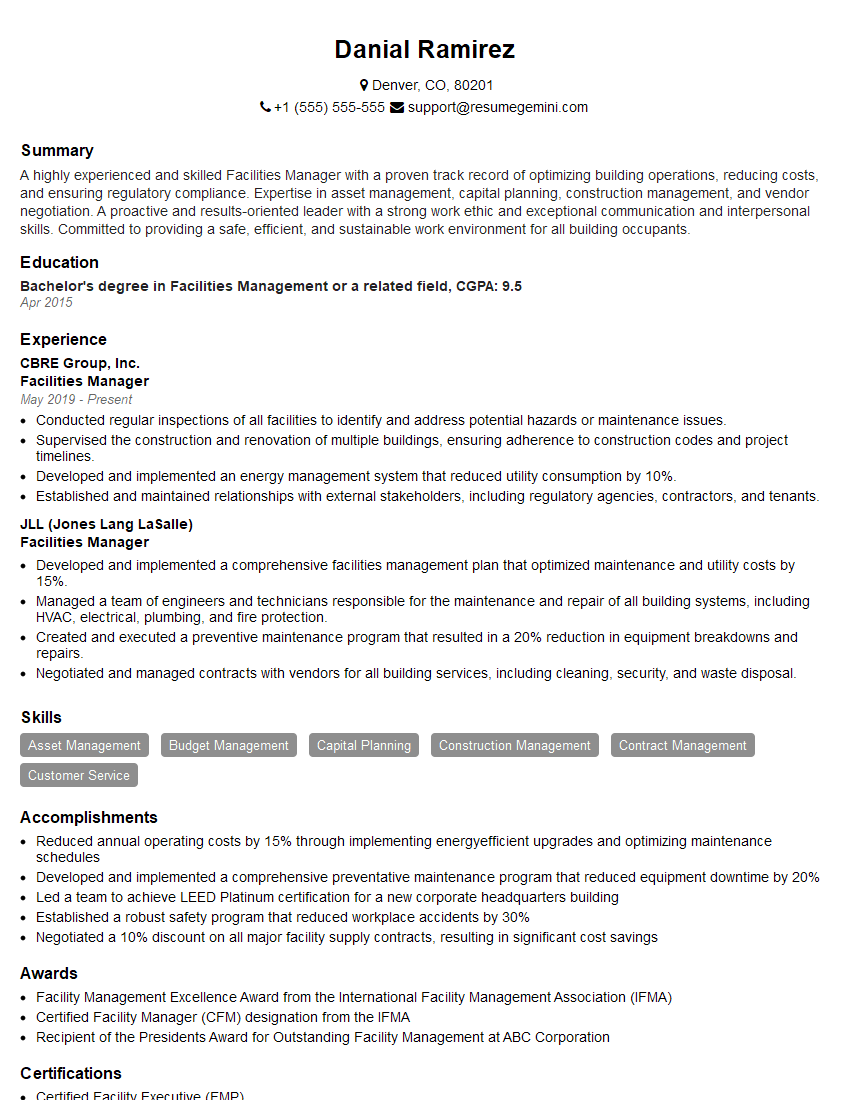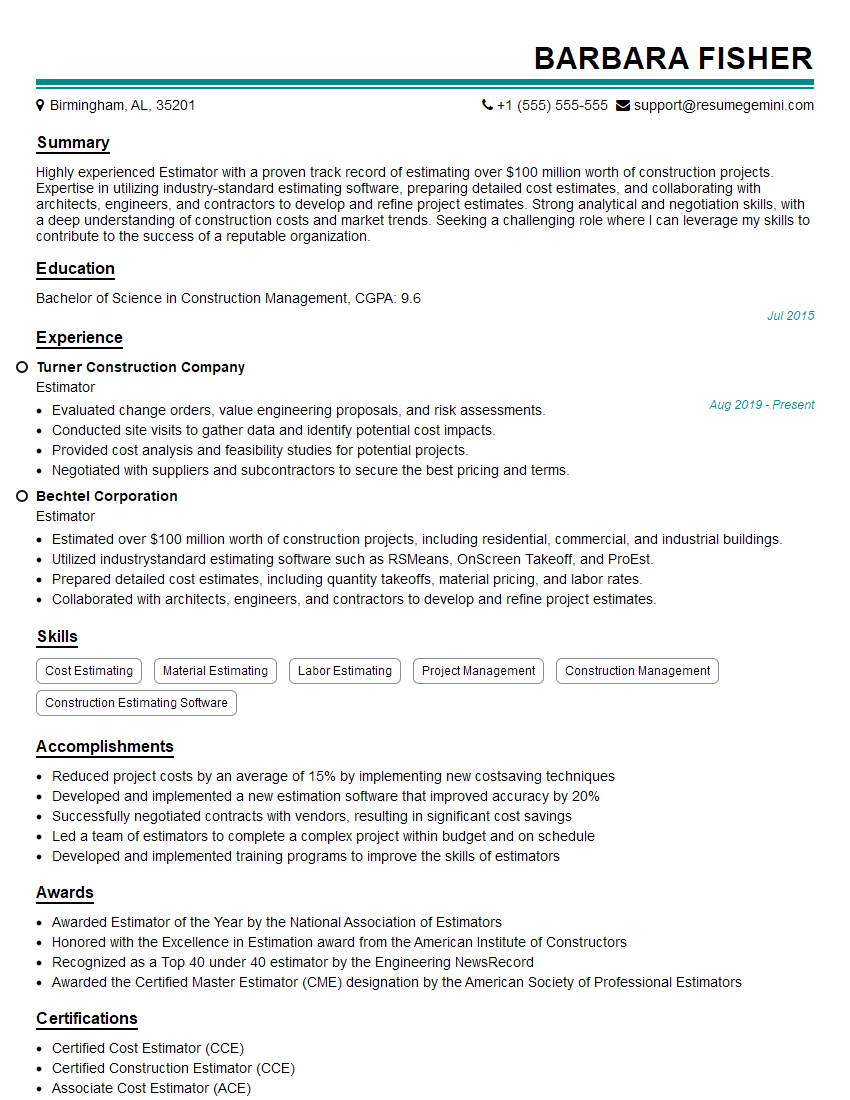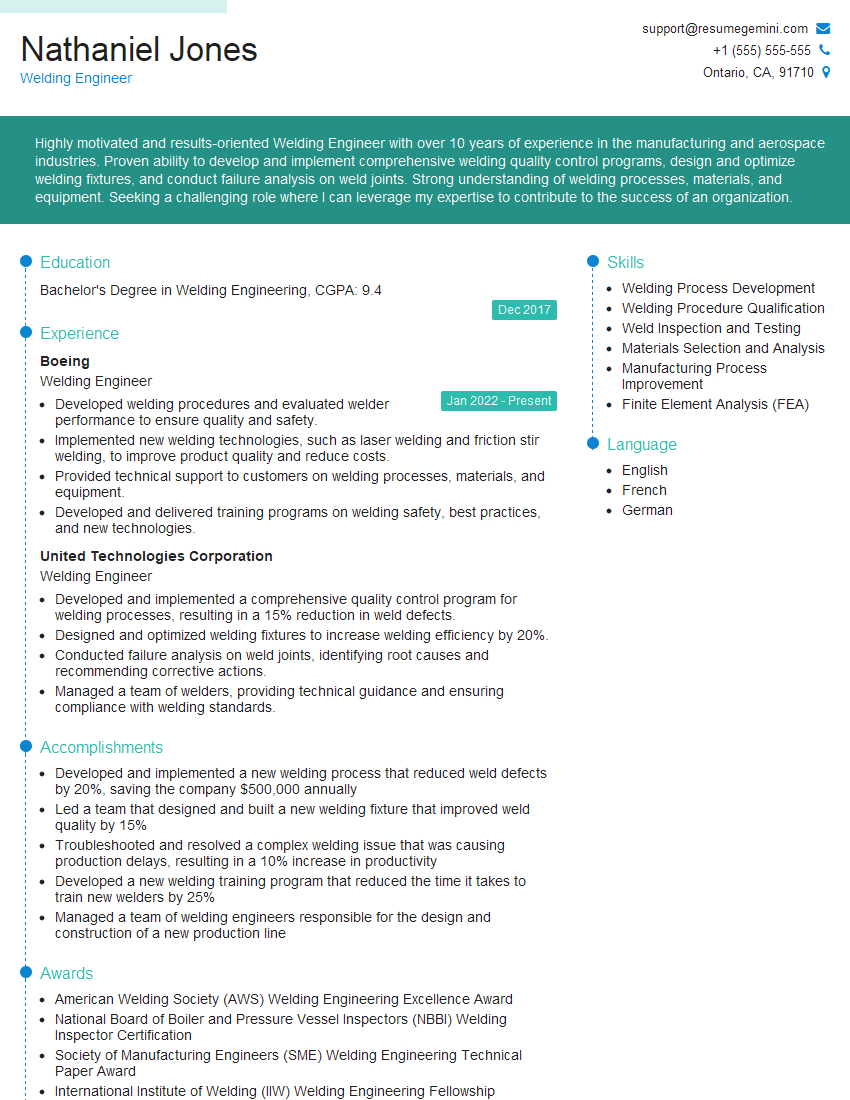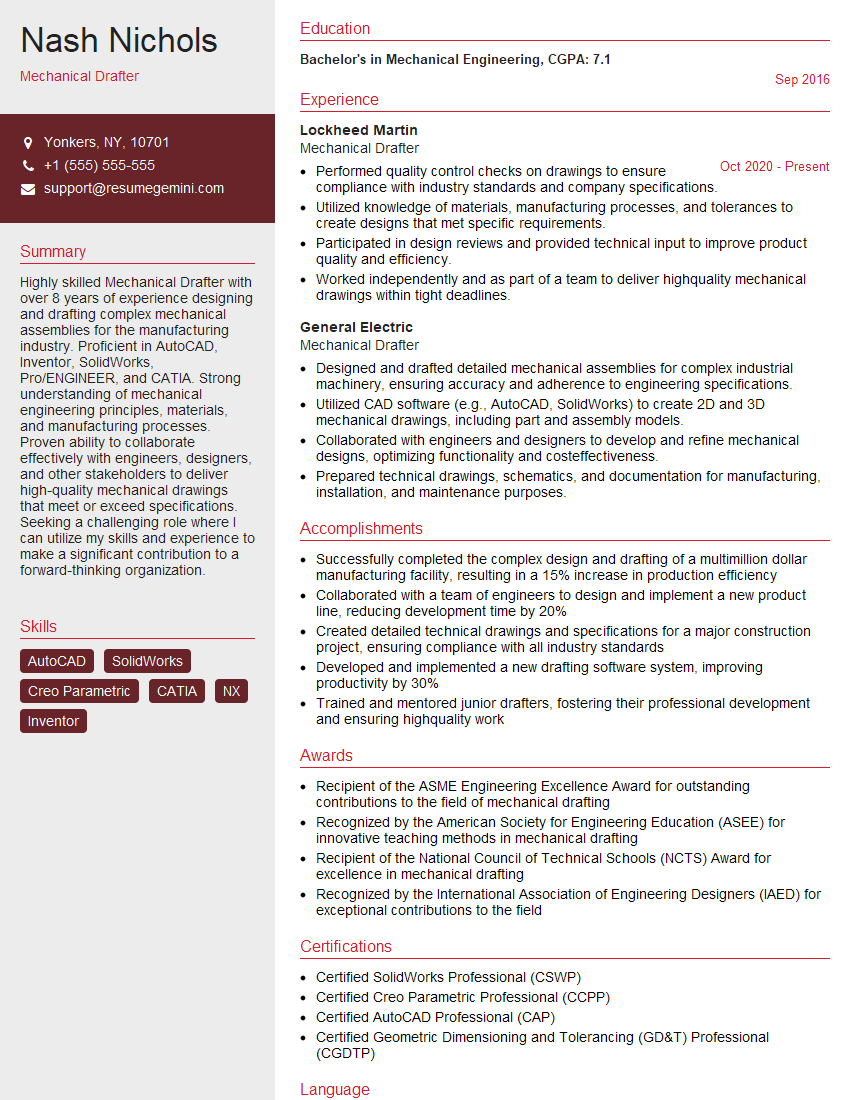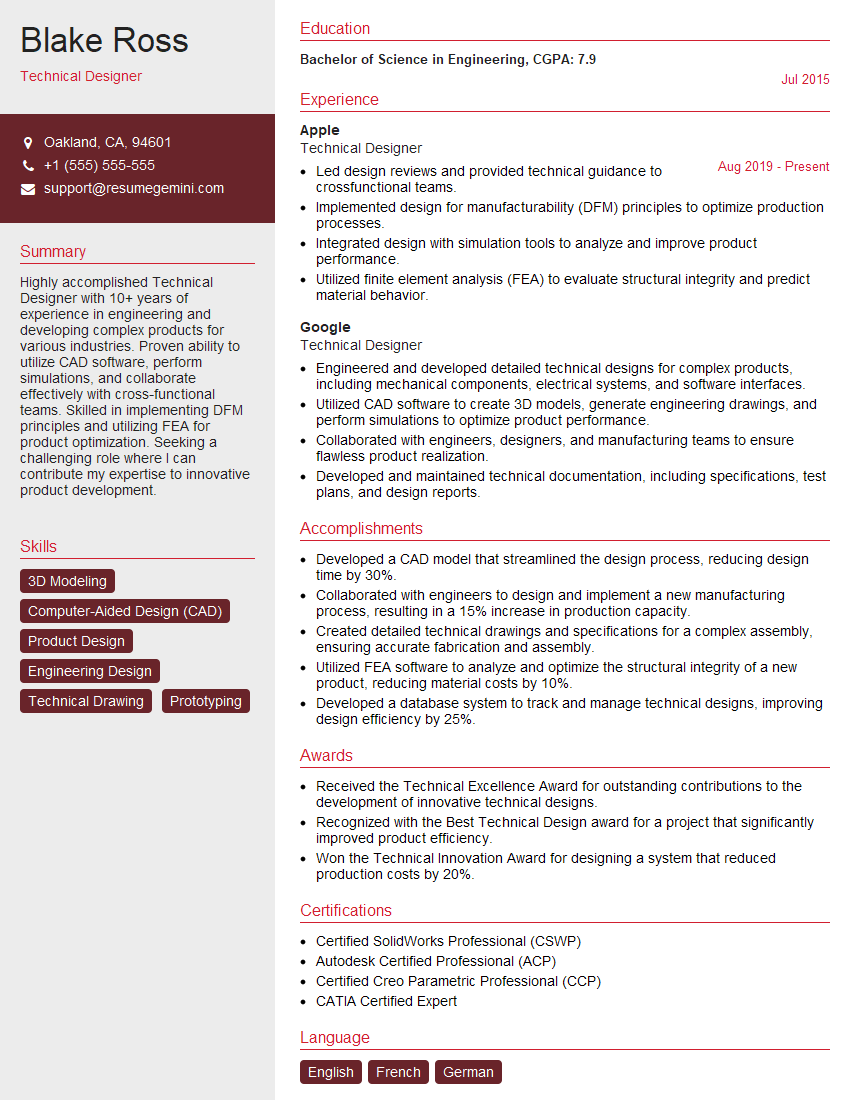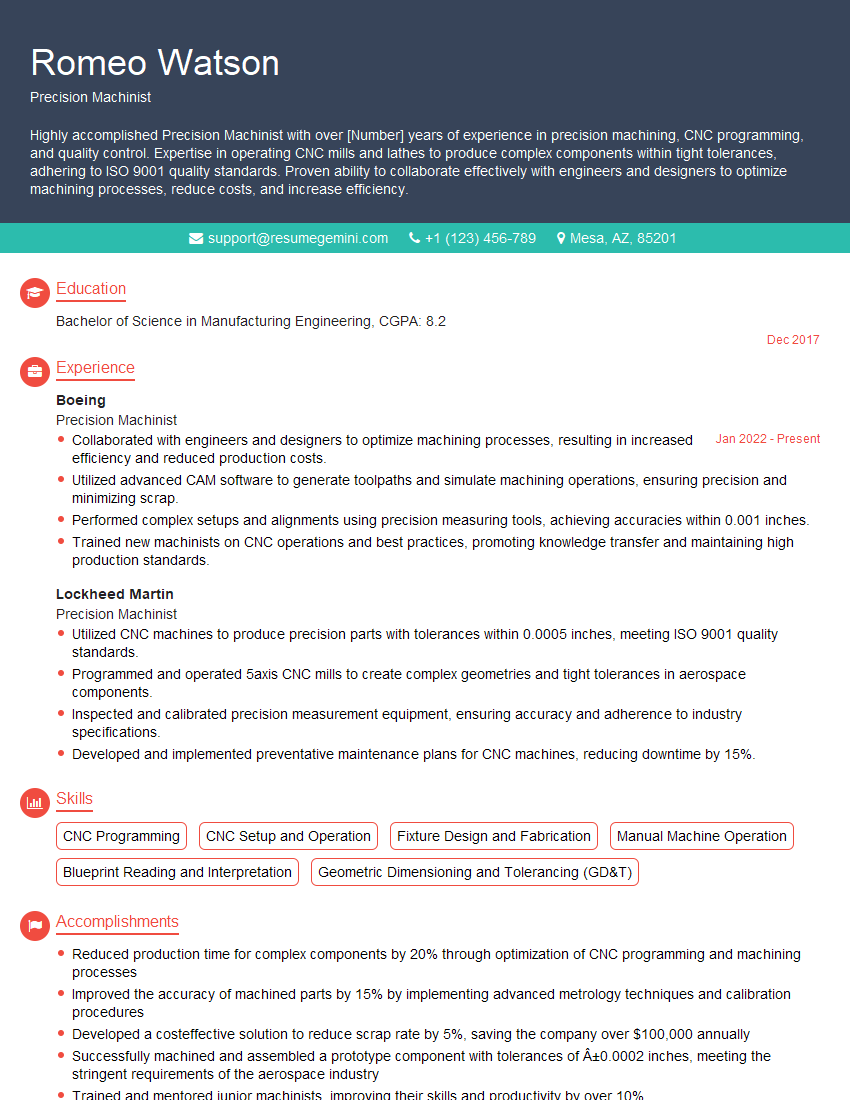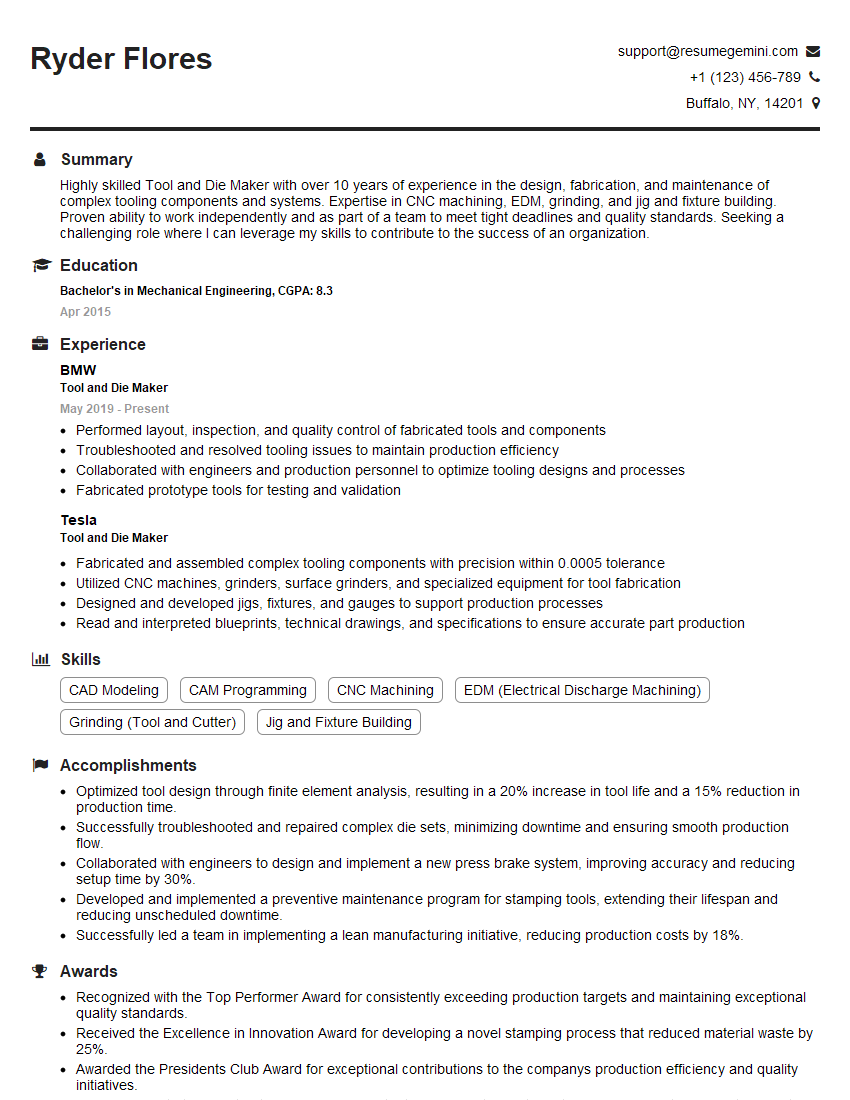Feeling uncertain about what to expect in your upcoming interview? We’ve got you covered! This blog highlights the most important Shop Math and Calculations interview questions and provides actionable advice to help you stand out as the ideal candidate. Let’s pave the way for your success.
Questions Asked in Shop Math and Calculations Interview
Q 1. Calculate the area of a trapezoid with bases of 10cm and 15cm and a height of 8cm.
The area of a trapezoid is calculated using the formula: Area = 1/2 * (base1 + base2) * height. Think of it like finding the average of the two bases and then multiplying by the height. It’s essentially calculating the area of a rectangle with a slanted top and bottom, then averaging it out.
In this case, base1 = 10cm, base2 = 15cm, and height = 8cm. Let’s plug the values into the formula:
Area = 1/2 * (10cm + 15cm) * 8cm = 1/2 * 25cm * 8cm = 100cm²Therefore, the area of the trapezoid is 100 square centimeters.
Q 2. Convert 150 millimeters to inches.
To convert millimeters to inches, we use the conversion factor: 1 inch = 25.4 millimeters. This means there are approximately 25.4 millimeters in every inch.
To convert 150 millimeters to inches, we divide the number of millimeters by the conversion factor:
150mm / 25.4mm/inch ≈ 5.91 inchesSo, 150 millimeters is approximately equal to 5.91 inches. Remember to always specify units in your calculations!
Q 3. What is the volume of a cylinder with a radius of 5 inches and a height of 12 inches?
The volume of a cylinder is calculated using the formula: Volume = π * r² * h, where ‘r’ is the radius and ‘h’ is the height. Imagine stacking many circles on top of each other; each circle represents the cylinder’s cross-sectional area.
In this case, the radius (r) is 5 inches and the height (h) is 12 inches. Using π ≈ 3.14159, we calculate:
Volume = 3.14159 * (5 inches)² * 12 inches ≈ 942.48 cubic inchesTherefore, the volume of the cylinder is approximately 942.48 cubic inches.
Q 4. Calculate the circumference of a circle with a diameter of 20cm.
The circumference of a circle is the distance around it. It’s calculated using the formula: Circumference = π * d, where ‘d’ is the diameter. This formula essentially measures the distance around the circle.
Given a diameter (d) of 20cm, the circumference is:
Circumference = 3.14159 * 20cm ≈ 62.83cmTherefore, the circumference of the circle is approximately 62.83 centimeters.
Q 5. If a bolt has 16 threads per inch, how many threads are in 2.5 inches?
If a bolt has 16 threads per inch, this means that in one inch of bolt length, there are 16 individual threads. To find the total number of threads in 2.5 inches, simply multiply:
Total threads = 16 threads/inch * 2.5 inches = 40 threadsTherefore, there are 40 threads in 2.5 inches of the bolt.
Q 6. What is the Pythagorean theorem, and how is it applied in shop calculations?
The Pythagorean theorem states that in a right-angled triangle, the square of the hypotenuse (the side opposite the right angle) is equal to the sum of the squares of the other two sides (called legs or cathetus). It’s expressed as: a² + b² = c², where ‘c’ is the hypotenuse, and ‘a’ and ‘b’ are the legs.
In shop calculations, this theorem is crucial for determining unknown lengths. For example, when you need to find the length of a diagonal brace on a rectangular frame, or calculating the length of a cut needed for a miter joint.
Example: Imagine you’re building a rectangular picture frame with sides of 12 inches and 16 inches. To find the length of the diagonal brace, you apply the Pythagorean theorem:
12² + 16² = c²144 + 256 = c²c² = 400c = √400 = 20 inchesThe diagonal brace needs to be 20 inches long.
Q 7. Explain the concept of tolerance and its importance in manufacturing.
Tolerance in manufacturing refers to the permissible variation from a specified dimension or value. It’s the acceptable range of error in a measurement. Imagine you’re making a hole – it won’t be perfectly the size you specify, but it needs to be close enough to function correctly. That ‘close enough’ range is defined by tolerance.
Tolerance is expressed as a range (e.g., 10mm ± 0.1mm), indicating the acceptable upper and lower limits. It’s crucial for ensuring that parts fit together correctly, operate reliably, and meet quality standards. Too tight tolerances are costly and difficult to achieve; too loose tolerances can lead to malfunctioning parts.
Importance:
- Interchangeability: Parts made with proper tolerances are interchangeable. You don’t need to hand-pick each component.
- Functionality: Tolerances ensure that parts fit and function as intended.
- Cost-effectiveness: Reasonable tolerances balance cost and quality.
- Quality control: Tolerances provide a benchmark for quality control and inspection.
Q 8. How do you calculate the surface area of a rectangular prism?
Calculating the surface area of a rectangular prism involves finding the area of each of its six faces and adding them together. Imagine you’re wrapping a present – you need enough wrapping paper to cover every side!
A rectangular prism has three dimensions: length (l), width (w), and height (h). The formula is:
Surface Area = 2lw + 2lh + 2whLet’s say we have a box with a length of 10cm, a width of 5cm, and a height of 3cm. Plugging these values into the formula:
Surface Area = 2(10cm * 5cm) + 2(10cm * 3cm) + 2(5cm * 3cm) = 100cm² + 60cm² + 30cm² = 190cm²Therefore, the surface area of this rectangular prism is 190 square centimeters.
Q 9. Describe different types of measurement units used in manufacturing.
Manufacturing uses a variety of measurement units, both metric and imperial. The choice depends on the industry, the country, and legacy systems. Here are some common ones:
- Length: Millimeters (mm), centimeters (cm), meters (m), kilometers (km) (metric); Inches (in), feet (ft), yards (yd), miles (mi) (imperial)
- Area: Square millimeters (mm²), square centimeters (cm²), square meters (m²), square kilometers (km²) (metric); Square inches (in²), square feet (ft²), square yards (yd²), acres, square miles (mi²) (imperial)
- Volume: Cubic millimeters (mm³), cubic centimeters (cm³), cubic meters (m³) (metric); Cubic inches (in³), cubic feet (ft³), cubic yards (yd³) (imperial); Liters (L) and gallons (gal) are also frequently used for volume, especially for liquids.
- Weight/Mass: Grams (g), kilograms (kg), tonnes (t) (metric); Ounces (oz), pounds (lb), tons (imperial)
- Angles: Degrees (°), radians (rad)
Consistency within a project is crucial to avoid errors. Choosing the right unit is vital for accuracy and safety.
Q 10. How do you convert between metric and imperial units?
Converting between metric and imperial units requires knowing the conversion factors. It’s like translating between two languages.
- Length: 1 inch = 25.4 millimeters; 1 foot = 0.3048 meters; 1 yard = 0.9144 meters
- Area: Remember that area conversions involve squaring the length conversion factor. For example, since 1 inch = 25.4 mm, 1 square inch = (25.4 mm)² = 645.16 mm²
- Volume: Similarly, volume conversions involve cubing the length conversion factor. 1 cubic inch = (25.4 mm)³ = 16387 mm³
- Weight/Mass: 1 pound = 0.453592 kilograms; 1 ounce = 28.35 grams
Example: Convert 10 inches to centimeters. Since 1 inch ≈ 2.54 cm, 10 inches * 2.54 cm/inch = 25.4 cm
Online converters or conversion tables are helpful resources to ensure accuracy, especially for more complex conversions.
Q 11. Explain the concept of trigonometry and its application in shop math.
Trigonometry is the study of triangles, specifically the relationships between their angles and sides. In shop math, it’s essential for calculating angles, distances, and heights, especially when dealing with non-right angled triangles. Think of it as a powerful tool for indirect measurement.
Key trigonometric functions:
- Sine (sin): Opposite side / Hypotenuse
- Cosine (cos): Adjacent side / Hypotenuse
- Tangent (tan): Opposite side / Adjacent side
Application: Imagine you need to find the height of a building using only a distance measurement and an angle of elevation. Using trigonometry (specifically the tangent function), you can calculate the height. Many shop calculations involving angles and slopes rely heavily on trigonometric principles.
Q 12. How would you calculate the angle needed to cut a specific bevel?
Calculating the angle needed for a specific bevel depends on the desired slope or ratio. This often involves using the inverse tangent function (tan⁻¹).
Example: Let’s say you need a bevel with a rise of 1 unit for every 5 units of run (a 1:5 slope). This means the opposite side of your right-angled triangle is 1, and the adjacent side is 5.
The angle (θ) can be found using:
θ = tan⁻¹(opposite/adjacent) = tan⁻¹(1/5)Using a calculator, you’ll find that θ is approximately 11.3 degrees. This is the angle you’d need to set your saw or bevel gauge to.
Remember to always double-check your calculations and measurements to ensure accuracy in your work.
Q 13. What are the common formulas for calculating the area of different geometric shapes?
Knowing the area formulas for common geometric shapes is fundamental to many shop calculations. Here are some important ones:
- Rectangle: Area = length * width
- Square: Area = side * side (or side²)
- Triangle: Area = (1/2) * base * height
- Circle: Area = π * radius² (where π ≈ 3.14159)
- Trapezoid: Area = (1/2) * (base1 + base2) * height
Understanding these formulas allows you to calculate material requirements, estimate costs, and solve various layout problems in a workshop.
Q 14. How do you calculate the volume of irregular shapes?
Calculating the volume of irregular shapes can be challenging. There isn’t a single, straightforward formula. However, several methods can be employed, depending on the shape’s complexity.
- Water displacement: Submerge the object in a container of water and measure the volume of water displaced. This is a simple, practical method for irregularly shaped objects that are waterproof.
- Geometric approximation: Break down the irregular shape into smaller, more regular shapes (cubes, prisms, etc.) and estimate the volume of each. Sum these volumes to get an approximate total. This method’s accuracy depends on how well you can approximate the irregular shape.
- 3D scanning and software: Advanced techniques involve using 3D scanners to create a digital model of the object and using specialized software to calculate its volume. This provides high accuracy, especially for complex shapes.
The best method depends on the resources available and the required accuracy.
Q 15. Explain the concept of ratios and proportions and their application in shop calculations.
Ratios and proportions are fundamental concepts in shop math. A ratio is a comparison of two quantities, often expressed as a fraction (e.g., 3:4 or 3/4). A proportion is a statement that two ratios are equal (e.g., 3/4 = 6/8). In shop calculations, ratios help determine scale factors for blueprints, mixture proportions for adhesives or paints, and gear ratios in machinery. Proportions are used to solve problems involving similar triangles (e.g., calculating the height of an object using its shadow), scaling dimensions up or down, and calculating material quantities based on given ratios.
Example: Imagine you’re enlarging a blueprint. If the blueprint scale is 1:100 (meaning 1 unit on the blueprint represents 100 units in real life), and a part measures 2.5 cm on the blueprint, its actual size is found using proportion: 1/100 = 2.5/x. Solving for x gives x = 250 cm. This demonstrates how proportions enable accurate scaling in shop work.
Career Expert Tips:
- Ace those interviews! Prepare effectively by reviewing the Top 50 Most Common Interview Questions on ResumeGemini.
- Navigate your job search with confidence! Explore a wide range of Career Tips on ResumeGemini. Learn about common challenges and recommendations to overcome them.
- Craft the perfect resume! Master the Art of Resume Writing with ResumeGemini’s guide. Showcase your unique qualifications and achievements effectively.
- Don’t miss out on holiday savings! Build your dream resume with ResumeGemini’s ATS optimized templates.
Q 16. How do you use a micrometer to measure an object’s dimensions?
A micrometer, or micrometer screw gauge, is a precision instrument for measuring extremely small distances with high accuracy, typically up to a few centimeters. Its operation relies on a precise screw mechanism.
- Zeroing: First, ensure the micrometer is properly zeroed by closing the anvil and spindle completely and checking that the reading is zero.
- Object Placement: Carefully place the object to be measured between the anvil and the spindle.
- Measurement: Slowly turn the thimble until the object is lightly held between the anvil and spindle. Avoid excessive force.
- Reading: The measurement is read in two parts: the main scale (sleeve) and the rotating scale (thimble). The sleeve shows the millimeters, while the thimble shows the hundredths of a millimeter (or smaller increments depending on the micrometer). Sum up the readings on both scales to get the total measurement.
Example: If the sleeve shows 5 mm and the thimble indicates 0.37 mm, the total measurement is 5.37 mm.
Q 17. How do you use calipers to measure an object’s dimensions?
Calipers are used to measure the external or internal dimensions of objects. There are two main types: vernier calipers and digital calipers.
- Vernier Calipers: These use a main scale (fixed jaw) and a vernier scale (movable jaw) to achieve higher accuracy. Measure the object by placing it between the jaws and carefully locking the slide. Read the measurement from the main scale and the vernier scale, combining both for the final dimension.
- Digital Calipers: These provide a digital readout of the measurement, eliminating the need for manual interpretation. They operate similarly to vernier calipers, with the object placed between the jaws and the measurement displayed on a digital screen.
Example: When using vernier calipers, if the main scale reads 2.5 cm and the vernier scale indicates 0.07 cm, the combined measurement is 2.57 cm. Digital calipers will simply display the 2.57 cm directly.
Q 18. Explain the concept of significant figures and their importance in accuracy.
Significant figures are the digits in a number that carry meaning contributing to its measurement resolution. They indicate the precision of a measurement. The more significant figures, the more precise the measurement.
- Rules for Determining Significant Figures: All non-zero digits are significant. Zeros between non-zero digits are significant. Leading zeros are not significant. Trailing zeros in a number containing a decimal point are significant. Trailing zeros in a number without a decimal point are ambiguous and should be avoided by using scientific notation.
Importance: In shop calculations, accuracy is paramount. Using the correct number of significant figures prevents overstating the precision of measurements and calculations. For instance, reporting a measurement as 10.00 cm implies a higher degree of precision than reporting it as 10 cm.
Example: 12.34 has four significant figures; 0.0123 has three; 1000 has only one, unless it is written as 1.000 x 103, then it has four.
Q 19. How do you calculate the percentage error in a measurement?
Percentage error quantifies the relative difference between a measured value and an accepted or true value. It shows the accuracy of a measurement, irrespective of the magnitude of the measurement.
The formula is: Percentage Error = [(|Measured Value - True Value|) / True Value] x 100%
Example: If the true diameter of a shaft is 10.00 mm and you measure it as 9.95 mm, the percentage error is: [(|9.95 - 10.00|) / 10.00] x 100% = 0.5%. This indicates a reasonably accurate measurement.
Q 20. How would you determine the appropriate drill bit size for a given screw size?
Selecting the correct drill bit size for a screw is crucial for a secure and clean fit. There is no universally standard drill bit size for every screw size, as it depends on the screw type and material. However, general guidelines exist.
Approach: Consult a drill bit size chart specifically designed for screw sizes. These charts often provide the appropriate drill bit size for various screw types (wood screws, machine screws, etc.). Alternatively, the screw packaging may contain this information. If such resources aren’t available, a slightly smaller diameter than the screw’s shank diameter is a safe starting point, ensuring a snug fit without splitting the material.
Example: A common practice for wood screws is to use a drill bit that’s slightly smaller than the screw’s shank diameter. You might use a 1/8-inch bit for a #6 wood screw.
Important note: Always refer to manufacturer’s specifications or use well-established guidelines. Using an incorrect drill bit size can result in stripped screws or damaged materials.
Q 21. Explain the use of different types of measuring instruments.
Various measuring instruments are used in shop work, each suited for specific tasks and levels of precision.
- Rulers and Tape Measures: For basic linear measurements, providing relatively low precision.
- Vernier Calipers and Micrometers: For higher precision linear measurements, ideal for mechanical components and precise adjustments.
- Dial Indicators: To measure small displacements or surface irregularities, useful for checking alignment and flatness.
- Angle Gauges: To measure angles with precision, important for machining and carpentry.
- Levels: To ensure surfaces are perfectly horizontal or vertical, crucial in construction and machine setup.
- Protractors: For measuring angles, particularly in applications such as drafting and design.
The choice of instrument depends on the accuracy and type of measurement required for the specific shop task. Using the right tool ensures efficiency and accuracy in the work.
Q 22. How do you interpret engineering drawings and blueprints?
Interpreting engineering drawings and blueprints requires a systematic approach. First, you need to understand the drawing’s scale, which indicates the ratio between the drawing’s dimensions and the actual object’s dimensions. For example, a scale of 1:10 means one inch on the drawing represents ten inches on the actual part. Next, you identify the different views (top, front, side) to visualize the object’s three-dimensional form. Pay close attention to the lines used; solid lines usually represent visible edges, while dashed lines indicate hidden edges or features. Dimensions are crucial – they provide the precise measurements of lengths, widths, heights, and angles. Symbols and annotations also play a key role; they often denote materials, finishes, tolerances (allowable variations in dimensions), and other important specifications. Think of it like assembling a puzzle – each line, dimension, and symbol is a piece that contributes to the complete picture.
For instance, I once worked on a project requiring the fabrication of a complex mounting bracket. The blueprint included multiple views, sections, and detailed dimensions. By systematically analyzing these, I accurately determined the material requirements, machining operations, and assembly procedures. Understanding orthographic projections (different views showing different faces) was key to visualizing the three-dimensional nature of the part.
Q 23. How do you calculate gear ratios?
Gear ratios describe the relationship between the rotational speeds of two gears meshing together. It’s essentially a comparison of the number of teeth on each gear. A simple gear ratio is calculated by dividing the number of teeth on the driven gear (the gear receiving power) by the number of teeth on the driving gear (the gear providing power). For example, if the driving gear has 20 teeth and the driven gear has 60 teeth, the gear ratio is 60/20 = 3:1. This means the driven gear rotates three times slower than the driving gear, but with three times the torque (rotational force).
In more complex systems with multiple gears, you multiply the ratios of each gear pair to find the overall gear ratio. Consider a system with three gears: Gear A (driving, 20 teeth) meshes with Gear B (intermediate, 40 teeth), and Gear B meshes with Gear C (driven, 80 teeth). The ratio between A and B is 40/20 = 2:1, and the ratio between B and C is 80/40 = 2:1. Therefore, the overall gear ratio from A to C is 2 x 2 = 4:1. This indicates that Gear C rotates four times slower than Gear A, but with four times the torque.
Q 24. How do you calculate RPM (Revolutions Per Minute)?
RPM, or Revolutions Per Minute, measures how many complete rotations an object makes in one minute. Calculating RPM depends on the context. For example, with rotating machinery driven by a motor, you might know the motor’s speed in RPM. However, if you know the speed of a rotating shaft and need to determine the RPM of a connected gear, you’d use the gear ratio discussed previously. If you are dealing with something like a wheel, you can determine RPM by measuring the number of revolutions in a set time interval (e.g., 15 revolutions in 30 seconds). Then, you would convert that to revolutions per minute by multiplying by 2 (30 seconds is half a minute).
Another method involves using the tangential velocity (speed of a point on the circumference of a rotating object) and the circumference of the object. The formula is RPM = (Velocity in feet per minute)/(Circumference in feet). For example, imagine a wheel with a circumference of 3.14 feet moving at 15.7 feet per minute. Then the RPM is 15.7/3.14 = 5 RPM.
Q 25. What is the difference between accuracy and precision in measurement?
Accuracy refers to how close a measurement is to the true or accepted value. Precision, on the other hand, refers to how close repeated measurements are to each other. Think of it like shooting arrows at a target. High accuracy means your arrows are clustered around the bullseye (close to the true value), while high precision means your arrows are clustered tightly together, regardless of whether they are near the bullseye. You can have high precision with low accuracy (arrows clustered but far from the bullseye), high accuracy with low precision (arrows scattered but centered around the bullseye), or ideally, both high accuracy and high precision (arrows clustered around the bullseye).
In shop math, ensuring both accuracy and precision is vital. For example, when machining a part, accurate measurements are crucial for meeting design specifications. Precision in measurements is equally important for consistent results and minimizing errors across multiple units. I use calibrated instruments and repeat measurements to ensure both.
Q 26. How do you calculate the area of a complex shape?
Calculating the area of complex shapes often involves breaking them down into simpler, more manageable shapes like rectangles, triangles, and circles. For example, an irregular polygon can be divided into several triangles. You then calculate the area of each simpler shape using the appropriate formulas (rectangle: length x width; triangle: 0.5 x base x height; circle: πr²), and then sum the areas to obtain the total area of the complex shape. For shapes that cannot be easily divided into standard shapes, numerical integration techniques like the trapezoidal rule or Simpson’s rule might be used, often with the help of CAD software.
I often use this approach in sheet metal fabrication. To determine the material needed for a complex part, I’ll sketch the part on graph paper and divide it into rectangles and triangles, calculating their areas, and adding them to get a total area. This helps determine the necessary sheet size minimizing waste.
Q 27. Describe your experience with using shop math in a practical setting.
Shop math is integral to my daily work. In a recent project involving the construction of a custom-designed jig, I used trigonometry to calculate angles for precise placement of components. To ensure the jig’s structural integrity, I had to apply principles of statics (balance of forces) to verify that the forces applied wouldn’t cause failure. Also, I regularly use geometry to determine the dimensions of parts and materials needed, ensuring accurate cutting and assembly. Calculating surface areas and volumes is vital for determining material quantities and costing. For example, I recently used volume calculations to determine the amount of epoxy resin needed for a large casting project, saving both material and time.
Q 28. How do you handle errors or discrepancies in your calculations?
When discrepancies arise, I employ a systematic approach. First, I double-check my calculations meticulously, looking for simple arithmetic errors or mistakes in formula application. Then, I examine the source data for errors or inconsistencies, verifying measurements and specifications from drawings or other sources. If the discrepancy persists, I might repeat the calculation using a different method or tool, perhaps using a calculator or software package to verify. If I still can’t resolve the discrepancy, I consult with colleagues or supervisors. Documenting each step of the process is crucial so that the source of the error can be traced and future mistakes can be avoided. This collaborative approach ensures the accuracy of my work and contributes to a safe and effective working environment.
Key Topics to Learn for Shop Math and Calculations Interview
- Unit Conversions: Mastering conversions between different units of measurement (e.g., inches to centimeters, pounds to kilograms) is fundamental in shop environments. This ensures accuracy in material ordering and project planning.
- Geometry and Trigonometry: Understanding geometric shapes, angles, and trigonometric functions is crucial for calculating areas, volumes, and angles necessary for precise cutting, machining, and assembly.
- Fractions, Decimals, and Percentages: Proficiency in these areas is essential for accurate measurements, material calculations, and understanding tolerances.
- Ratio and Proportion: Solving problems involving ratios and proportions is vital for scaling drawings, mixing materials, and maintaining consistent production.
- Basic Algebra: Applying algebraic equations and formulas is critical for solving problems related to material costs, production times, and optimizing processes.
- Blueprint Reading and Interpretation: Accurately interpreting blueprints and technical drawings requires a strong understanding of scales, dimensions, and annotations.
- Measurement Techniques: Understanding different measurement tools (e.g., calipers, micrometers) and their precision is paramount for accurate work.
- Calculating Material Needs: Accurately estimating material requirements based on project specifications and minimizing waste are important skills.
- Problem-Solving Strategies: Developing a systematic approach to problem-solving, including identifying the problem, gathering information, and selecting appropriate formulas, is crucial for success.
Next Steps
Mastering shop math and calculations is vital for career advancement in any manufacturing or technical field. It demonstrates your attention to detail, problem-solving abilities, and commitment to accuracy – all highly sought-after qualities by employers. To significantly improve your job prospects, create an ATS-friendly resume that highlights these skills. We strongly encourage you to use ResumeGemini to build a professional and impactful resume. ResumeGemini offers a streamlined process and provides examples of resumes tailored to Shop Math and Calculations roles, helping you showcase your expertise effectively.
Explore more articles
Users Rating of Our Blogs
Share Your Experience
We value your feedback! Please rate our content and share your thoughts (optional).
What Readers Say About Our Blog
Hello,
We found issues with your domain’s email setup that may be sending your messages to spam or blocking them completely. InboxShield Mini shows you how to fix it in minutes — no tech skills required.
Scan your domain now for details: https://inboxshield-mini.com/
— Adam @ InboxShield Mini
Reply STOP to unsubscribe
Hi, are you owner of interviewgemini.com? What if I told you I could help you find extra time in your schedule, reconnect with leads you didn’t even realize you missed, and bring in more “I want to work with you” conversations, without increasing your ad spend or hiring a full-time employee?
All with a flexible, budget-friendly service that could easily pay for itself. Sounds good?
Would it be nice to jump on a quick 10-minute call so I can show you exactly how we make this work?
Best,
Hapei
Marketing Director
Hey, I know you’re the owner of interviewgemini.com. I’ll be quick.
Fundraising for your business is tough and time-consuming. We make it easier by guaranteeing two private investor meetings each month, for six months. No demos, no pitch events – just direct introductions to active investors matched to your startup.
If youR17;re raising, this could help you build real momentum. Want me to send more info?
Hi, I represent an SEO company that specialises in getting you AI citations and higher rankings on Google. I’d like to offer you a 100% free SEO audit for your website. Would you be interested?
Hi, I represent an SEO company that specialises in getting you AI citations and higher rankings on Google. I’d like to offer you a 100% free SEO audit for your website. Would you be interested?
good
